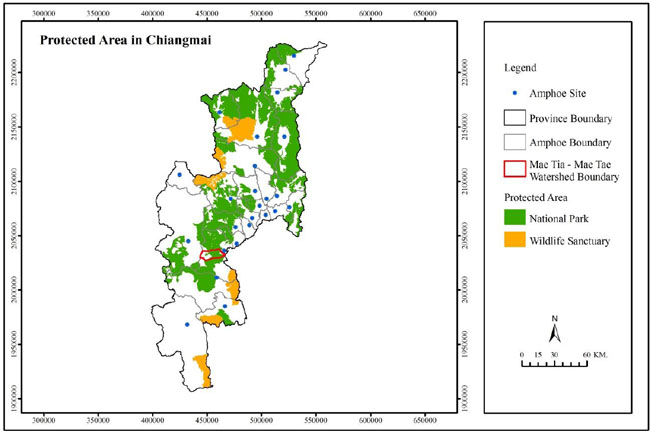Co-management in Land Demarcation to Reduce Forest Utilization Conflicts: A Case Study of Mae Tia-Mae Tae Watershed, Chom thong District, Chiang Mai Province
Main Article Content
Abstract
This research was based on the observation of phenomenon that occurred in every group of stakeholders through an implementation of modern management or co-management in land demarcation of the forest area in the Joint Management of Protected Area (JoMPA) In this regard, reviews of relevant concepts, theories, and study reports used in formulating explanation and utilization of natural resources along with an analysis of good points and limitations of the conventional explanation and management were conducted. It was also to evaluate how the conceptual thinking frameworks, management, and operating procedures of the co-management in land demarcation secured successful results. Afterwards, those results were subject to a proof through an implication of Geographic Information System (GIS) to detect any changes of the forest utilization based on the high-resolution satellite images and secondary data obtained from the project’s studies. Meanwhile, an analysis of accomplishments concerning a reduction of conflicts over the forest utilization along with a decline in the forest encroachment was also undertaken. The results disclosed that the land conflicts stemmed from unclear land use boundaries in need of mutual acceptance between the communities and government agencies. The co-management hereby is regarded as the mechanism bridging and transferring the management power to local stakeholders so that they can learn and find the solutions to settle arising problems in collaboration with the government agencies and other local organizations. Therefore, this co-management requires four components; 1) complete concepts for a holistic approach, 2) co-management mechanism, 3) co-management tools, and 4) clear and complete operating procedures. The success of land demarcation was collaboratively operated by four direct and indirect stakeholders; local communities, government agencies, non-government organizations (NGOs) and academic support groups. In this regard, topographic map and satellite image by Landsat and Ikonos were used to initially investigate the topography. Meanwhile, color aerial photography along with Global Positioning System (GPS) were also applied during a walkthrough survey to ensure the accurate land demarcation. In addition the evidence base as agreed by all concerned parties in the local community forums was used to map the color aerial photography land demarcation signed by relevant organizations such as Chom Thong Deputy District Chief, Local Administration Organizations, and Ob Luang National Park in the presence of NGOs, Sustainable Land Use and Natural Resource Management Academic Center (SLUSE), and others as a witness. This also resulted in the agreements and regulations for land utilization. The results of co-management in land demarcation bring an end to the conflicts over the land utilization between the high and low-land communities of the watershed as well as between the communities and government agencies. Upon the report of forest encroachment, the community committee and National Park’s authorities will retrieve the encroached Land and impose a fine against encroachers. According to the interpretation of satellite images, a reduction of forest encroachment was averagely at 8.64 ha per year during 2008-2010 after the co-management in land demarcation, compared to 27.39 ha per year during 2002-2008 before the land demarcation.
Article Details
Published articles are under the copyright of the Environment and Natural Resources Journal effective when the article is accepted for publication thus granting Environment and Natural Resources Journal all rights for the work so that both parties may be protected from the consequences of unauthorized use. Partially or totally publication of an article elsewhere is possible only after the consent from the editors.

